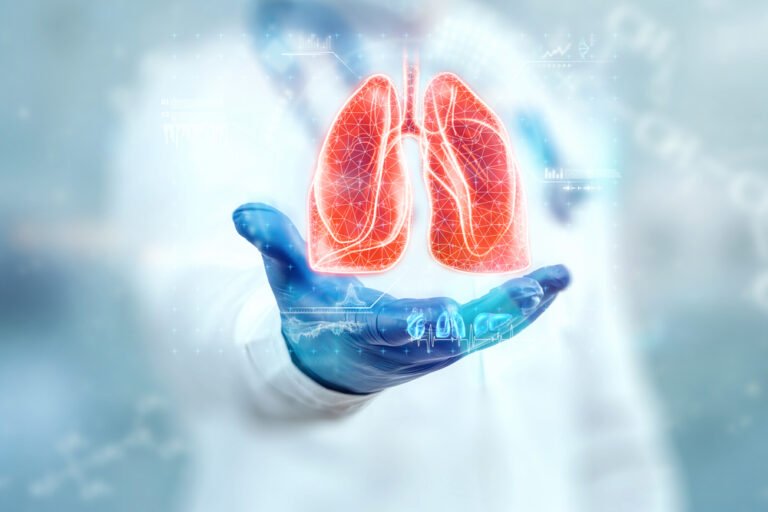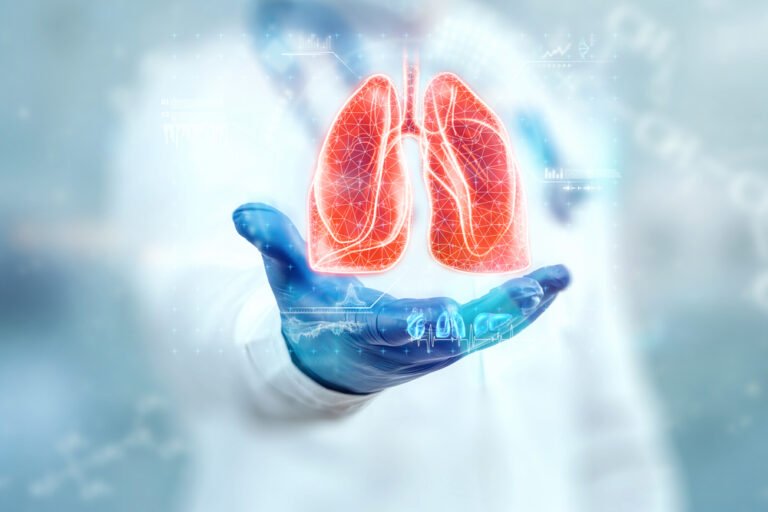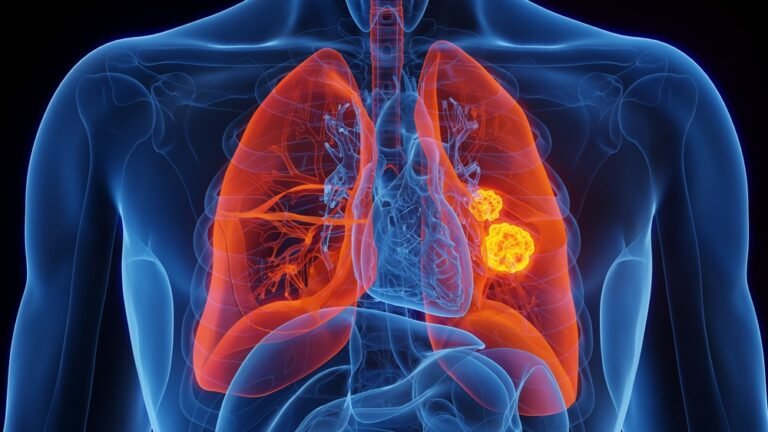Lung cancer remains an important cause of cancer death throughout the Western world and smoking is the leading cause of lung cancer
Understanding Lung Cancer Due To Smoking
Smoking affects lungs primarily due to the toxic chemicals present in tobacco smoke. There are 55 substances in cigarette smoke that are carcinogenic along with other agents like hydrogen cyanide, ammonia and carbon monoxide that all damage the lungs and are the main reason of Lung Cancer due to smoking.
Long term impacts of smoking on lungs
- Cigarette smoke contains carcinogens that form abnormal DNA that hamper normal DNA repair and replication as a result abnormal DNA keep replicating. Cigarette smoking also weakens immune system. Thus, leading to lung cancer.
- Toxic chemicals present in cigarette smoke cause irritation leading to inflammation of airways. Repeated and continuous exposure lead to permanent damage to lung tissue over time.
- Smoking increases mucus production in the airways. This excess mucus can block the air passages that not only makes breathing difficult but also increases the risk of infections such as pneumonia and bronchitis.
- In lungs there are tiny hair-like structures called cilia that are present along the length of airways. These are responsible for clearing mucus and debris from the lungs. Smoking damages and paralyzes these cilia leading to buildup of mucus and harmful substances in the lungs.
- Smoking damages the air sacs (alveoli) in the lungs resulting in loss of elasticity and impairing expansion and contraction of lungs. As a result lung becomes stiff.
- Smoking decreases lung volume and capacity i.e forced vital capacity (FVC, maximum amount of air a person can exhale forcefully and completely after taking a deep breath), forced expiratory volume in one second (FEV1 amount of air that can be forcefully exhaled in one second after taking a deep breath) . Both are important indicators of lung health and function.
- The reduction in FVC of smoker may be explained by the reduction in strength of the respiratory muscles. Cigarette smoking affects the respiratory muscles through the influence of free radicals on the vascular system16), leading to a reduction in respiratory muscle blood supply which adversely impacts respiratory function.
- The reduction in FEV1 is due to smoking induced resistance and inflammation of passages, loss of elasticity and increased mucus production all leading to narrowing and obstruction of airways.
Major lung disorders caused by smoking
-
COPD
(chronic obstructive pulmonary disease)
It includes 2 conditions
- Chronic bronchitis (characterized by increased mucus production and difficulty breathing due to inflammation of airways. Chronic bronchitis is characterized by a persistent cough with sputum production for at least three months in two consecutive years).
-
Emphysema
(characterized by difficulty breathing and cough due to destruction of air sacs i.e alveoli)
-
Pulmonary fibrosis
Condition which involves scarring of lungs and person develops shortness of breath and cough.
-
Pneumonia
Smoking decreases immunity of a person and makes it easy to catch different infections leading to pneumonia.
-
Pneumothorax
Presence of air or gas in the pleural cavity that is the area between the lung and the chest wall. It is an emergency condition and needs urgent treatment that involves removal of air with the help of a syringe and chest tube. Smoking is not a direct cause of pneumothorax emphysema which is caused by smoking can lead to pneumothorax.
-
Respiratory failure
There are two types of respiratory failures.
- Type 1 respiratory failure ; only level of oxygen is reduced in blood and carbon dioxide is normal.
- Type 2 respiratory failure ; level of oxygen is reduced along with increase in level of carbon dioxide in blood.
Smoking indirectly causes respiratory failure by causing or worsening underlying lung conditions i.e emphysema, and chronic bronchitis which are actually caused by smoking. This disturbance in levels of oxygen and carbon dioxide in blood leads to improper functioning of body.
-
Pulmonary Hypertension:
Smoking is one of a risk factor for pulmonary hypertension, a condition in which blood pressure in the arteries of the lungs is raised. Pulmonary hypertension can strain the right side of the heart, leading to right heart failure. It presents with difficulty breathing on walking and lying flat, swelling of body and syncope.
All these disorders and complications can be prevented if a person quits smoking and improves lung health.
Journey to Recovery: Healing Your Lungs After Quitting Smoking
Lung recovery after quitting smoking involves these steps
- Pulmonary rehabilitation
- Vaccinations
- Diet
- Life Style Measures
Pulmonary rehabilitation
Pulmonary rehabilitation is a supervised medical program that helps people who have lung diseases live and breathe better. This program helps in recovery of lung and in making lungs stronger after quitting smoking. During the program, different exercises and breathing techniques are taught. These exercises help improve oxygenation of lungs, improves lung volumes and capacity and shortness of breath. As a result shortness of breath , quality of life and ability to do daily activities like house work ,exercise improves.
Who should have pulmonary rehabilitation
Patients with following Chronic lung conditions benefit from pulmonary rehabilitation:
- COPD
- Interstitial lung disease
- Lung cancer
- Post Lung transplant
- Post Lung surgeries
- Asthma
- Cystic fibrosis
- Pulmonary hypertension
Pursed Lip breathing
- Inhale slowly through your nostrils.
- Purse your lips as if whistling or about to blow on something.
- Breathe out as slowly as possible through pursed lips. This should take at least twice as long as it did to breathe in.
Deep Breathing Exercise
- Inhaling deeply through nose filling the lungs as fully as possible.
- Holding breath for a few seconds.
- Exhaling slowly and completely through the mouth.
- Repeat for several breaths, gradually increasing the duration of inhalation, breath-holding, and exhalation.
Diaphragmatic breathing / Belly breathing
- Relax your shoulders and sit back or lie down.
- Place one hand on your belly and one on your chest.
- Inhale through your nose for 2 seconds, feeling the air move into your abdomen and feeling your stomach move out. Your stomach should move more than your chest does.
- Breathe out for 2 seconds through pursed lips while pressing on your abdomen.
Alternate nostril breathing
- Sit comfortably and place your left hand on your knee.
- Lift your right hand to your nose, exhale, and close your right nostril with your thumb.
- Inhale through your left nostril and then close it with your fingers.
- Release the right nostril and exhale, then inhale through the right nostril and close it.
- Exhale through the left nostril.
- Repeat for up to 5 minutes and end by exhaling through the left nostril.
Incentive spirometry
- Sit comfortably on bed or chair.
- Hold the incentive spirometer in an upright position. It has either a piston or ball in it.
- Place the mouthpiece in your mouth and tightly seal your lips around it.
- Breathe in as slowly and deeply as possible. Ball or piston will start rising. It should reach the marked point.
- Hold your breath for at least five seconds. Exhale slowly and allow the piston or ball to fall back to bottom.
- Rest for a few seconds, and then repeat for at least 10 times every hour you’re awake
Smoker patients benefited from the PR program at least as much as the patients who do not smoke. Furthermore, nicotine dependence and amount of cigarette decreased in smoker patients.
Diet After Quitting Smoking
Along with these exercises good water intake and diet has an important role in recovery of lungs. Water intake helps body get rid of toxins due to smoking and diet rich in antioxidants and high in fiber help in healing of lungs from smoking.
Vaccinations After Quitting Smoking
Vaccination has a very important role in prevention of various infections and healing of lungs after quitting smoking.
- Influenza ( flu shot)
- Pneumonia ( pneumococcal)
- Diptheria , pertussis , tetanus (dTaP)
- COVID 19
- Shingles
- Respiratory syncytial virus (RSV)
Life Style Measures
- Aerobic activities like walking, running or jumping rope help heart and lungs to function efficiently.
- Muscle-strengthening activities like weight-lifting build core strength, improving posture, and toning breathing muscles.
- Improve indoor air quality. Use air filters and lower pollutants such as artificial fragrances, mold, and dust.
All these steps and measures need to be adopted in order to help healing of your lungs and to make lungs stronger after quitting smoking.
How to Quit Smoking?
In order to heal lungs from smoking and prevent lung cancer , extremely important first step is to quit smoking. This is the foremost step towards healthy lung journey.
There are now three first-line medical options available to assist smokers to quit smoking.
- Nicotine replacement therapy
- Bupropion
- Varenicline
Nicotine replacement therapy
Duration : 8 weeks or more
- Patch
> 10 cigs per day and weight > 45kg
21mg/24hr patch or 15mg/16hr
< 10 cigs per day or weight < 45kg
14mg/24 patch or 10mg/16hrs
At the start of each day, the patient should place a new patch on a relatively hairless location, typically between the neck and waist. No restrictions on activity while using the patch. Patches should be applied as soon as the patient wakes up on their quit day. In patients who experience sleep disruption, advise the patient to remove the 24-hour patch prior to bedtime or use the 16-hour patch.
- Gum
>10 and less than 20 cigs per day
2mg gum, 8-12 per day
>20 cigs per day
4mg gum, 6-10 per day
Prescribing Instructions
Chewing technique. Gum should be chewed slowly until a peppery or mint taste emerges, and then parked between cheek and gum for 10 minutes or until the taste dissipates to facilitate nicotine absorption through the mouth.
Avoid eating and drinking anything except water for 15 minutes before and during chewing to avoid interference with the absorption of nicotine. Chew the gum on a fixed schedule (at least one piece every 1-2 hours during waking hours) for at least 1-3 months.
- Inhaler
>10 cigarettes per day
6-12 cartridges per day
- Lozenges
First cigarette > 30 mins after waking
2mg lozenge, 1 lozenge every 1-3 hours
First cigarette < 30 minutes after waking
4mg lozenge, 1 lozenge every 1-2 hours
- Sublingual tablet
Low dependence
2mg tablet every 1-2hrs
High dependence
Two 2mg tablet every 1-2hrs
Bupropion
It is basically an antidepressant, bupropion is a non-nicotine oral therapy which reduces the urge to smoke and reduces symptoms from nicotine withdrawal.
Begin with a dose of 150 mg once daily for 3 days, then increase to 150 mg twice daily for 7-12 weeks. Bupropion treatment is started 1-2 weeks before the patient quits smoking. For maintenance therapy, consider bupropion 150 mg BD for up to 6 months.
Varenicline
The recommended dose of varenicline is 1 mg twice daily following a 1 week titration as follows:
Days 1-3 0.5 mg O.D.
Days 4-7 0.5mg twice daily
Day 8 – till End of treatment 1mg twice daily
The patient should set a date to stop smoking and Varenicline dosing should start 1 week before this date. Patients should be treated for 12 weeks. Once the patient has successfully stopped smoking at the end of 12 weeks, an additional maintenance course of 12 weeks treatment with Varenicline 1 mg twice daily also recommended.
Second line treatment
Second-line medications are also efficacious for treating tobacco dependence but their role is limited mainly because they may have more potential side effects than the 1st line medications. These include:
- Nortriptyline
- Clonidine
SMOKERS’ FREQUENTLY ASKED QUESTIONS
Following are some of the commonly asked questions by smokers when they consult a health professional and their possible answer. Every individual is different and answers may have to be modified according to the specific situation. What message you give to a young person may not appeal to a middle aged person.
Q.1: I am 60 years old. I started smoking 40 years ago. Damage has already been done. Isn’t it too late to stop now? What would I gain by giving up smoking at this age?
Ans: It’s never too late to give up smoking. By stopping smoking, further damage to the lungs, heart and other organs would stop. Research on respiratory functions has shown that by stopping smoking patients are able to avoid further deterioration in lung functions, which allows them to continue performing all routine tasks in their life rather than becoming bedridden. Quality of life of an ex smoker is far superior compared to those who continue smoking.
Q.2: I have been smoking for over 20 years. Should I cut down on my cigarettes first or stop it altogether?
Ans. Research has shown that those who set a firm quit date and stop suddenly, have a better chance of quitting, compared to those who attempt a gradual reduction. However, reducing the number of cigarettes in the week before the quit date is helpful.
Q.3: I am addicted to the nicotine present in the cigarettes and you are prescribing me nicotine chewing gum for quitting smoking. Isn’t there a risk that I will be hooked on to nicotine chewing gum?
Ans: Nicotine taken through chewing gum only provides 1/3 to 1/2 of nicotine delivered by cigarettes. It helps in reducing the “CRAVING” & breaking the bad habit. Chances of getting hooked to nicotine chewing gum itself are less than 5%. By taking nicotine in gum form, exposure to the other 4700 toxins present in cigarettes is avoided.Nicotine itself does not cause Lung Cancer or Heart Attack.
Q.4: How many chewing gums should I use every day?
Ans: Someone who smokes between 10-20 cigarettes/day needs to use 1 (2mg) chewing gum every hour for about 10 to 15 hours (during awake hours). Most failures occur because people use less chewing gum than they need. One can also use additional gum at any time when there is an urge. Those who smoke more than 20 cigarettes should use a 4 mg chewing gum.
Q.5; How can I use the chewing gum and for how long?
Ans: Generally chewing gum is required for a period of 2 to 3 months. Most people tend to reduce its use as time passes (craving for smoking get less after the initial 2 weeks). “Chew and park” method is the best. It should stay for 10 minutes or until the taste dissipates to facilitate nicotine absorption through the mouth.
Q.6: I don’t like the bad taste of chewing gum! It’s very hard to chew!
Ans: Remember it is a medicine; not a sweet. For example, one takes Quinine despite its bitter taste, in order to treat Malaria. Most people do not like the taste of their first cigarette but after few days they begin to enjoy smoking. Similarly it takes few days before one starts feeling the benefit of nicotine chewing gum use.
Q.7: Do all smokers need Nicotine replacement therapy (NRT) , Bupropion or Varenicline as a smoking cessation aid?
Ans; If a person smokes less than 10 cigarettes/day and has had previous successful long term quit attempts without any problems then NRT or other medicines may not be necessary. But if patient has tried and failed previous “self-attempt” of quitting smoking then he or she should be advised to use some pharmacotherapy.
Q8. I have tried Nicotine Chewing gum before; it does not work for me…
Ans. Nicotine chewing gum does not give the same “pleasure” as cigarettes. It only provides 1/3 to 1/2 of nicotine that the cigarette was providing. It will certainly decrease the “craving” but will not give the same relief as cigarettes. Nicotine from Chewing gum is delivered slowly than from inhaled smoke. Most people who fail do not use adequate amounts of chewing gum or are not motivated enough to get rid of this addiction.
Q9. Is Nicotine chewing gum as effective as Nicotine patches?
Ans. All NRT (patch or chewing gum) are equally effective, one can combine the two products in heavily addicted smokers but there is no added benefit in controlled trials. There is sustained delivery of nicotine through skin patches compared to chewing gum.
Q10. I have developed mouth ulcer ever since I started using chewing gum…
Ans. Mouth ulcers are the symptoms of nicotine withdrawal, which usually settles down in a few days. They don’t occur because of using nicotine chewing gum.
Q11. I have heard that by quitting smoking I would gain weight, but I want to look fit?
Ans. Yes it’s true that one gains about 6 kgs of weight within a year of quitting smoking. Nicotine chewing gum would delay the weight gain. Slight weight gain has far less risks compared to the serious hazards associated with “smoking”. There is no need to worry too much about weight gain “Quitting smoking” & “controlling weight” should be tackled at a different time. One cannot climb two mountains at the same time.
Q12. Can I smoke one or two cigarettes after the quit date?
Ans. No, not at all. Not even one cigarette after the quit date. If you take even one cigarette you will go back to the same habit. “Do not feed a dying monster in your brain”!
Q13. Smoking helps me to relax in my very hectic and tense life. Whenever I try to quit smoking I become angry and start fighting with my colleagues
Ans. Anger & restlessness are nicotine withdrawal symptoms. These symptoms last only for a few weeks. It can be controlled by NRT.
Q14. My life is very stressful. Smoking helps me in coping with stress.
Ans. It is wrong to say that smoking decreases stress levels. Studies have shown that stress level at 4 weeks after quitting smoking is far less than the stress level during smoking. Smokers get 10- 15 episodes of stress every day which is relieved by smoking. In the first week after quitting smoking, smokers are more anxious but soon anxiety level goes down.
Q15. How do I use Bupropion?
Ans. You should start one week prior to quit date. Initially take 150 mg daily, then on the day of quitting increase to 150 mg / twice/ day. Continue for about 2 to 3 months.
Q16. Is there any contra induction to use of Bupropion ?
Ans. If somebody has H/O epilepsy or seizures then it should not be used.
Q17. What do I do if I get irresistible desire to smoke?
Ans. Remember the 4Ds: Delay acting on the urge to smoke. After five minutes the urge to smoke weakens and your resolve to quit will come back. Deep breathing Take a long slow breath in and slowly release it out again. Repeat three Drink water slowly holding it in your mouth a little longer to savour the taste. Do something else to take your mind off smoking. Doing some exercise is a good alternative.
Q18. My uncle smoked all his life but he is still alive at age 80. If smoking is so bad then why he is still alive?
Ans. It’s true that some people are more vulnerable to the effects of tobacco use then others. Genetic makeup of the individual does play a role in deciding the extent of damage caused by tobacco. Research has however clearly shown that half of all regular smokers will die prematurely from their smoking habit. On an average, smokers loose about 10 years of their life. For some smokers, years lost because of smoking may be as many as 35 years to as low as 1 to 2 years .The quality of life of a smoker is also much inferior compared to that of a non-smoker. An analogy is that of suicide: not everyone who commits suicide dies, but it is extremely deleterious nonetheless.
Q19. Life is full of risks in any case then why there is so much talk against smoking these days? What is the harm if someone smokes?
Ans. It’s true that life has many risks. However, humans are gifted with intellect to make rational decisions to minimize these risks. Smoking is today the single largest preventable cause of disease and death. Active or passive smoking has serious health risks. Quitting smoking is in our hand. We can protect ourselves from several diseases which are directly caused by tobacco abuse.
Q20. what are the side effects of Varenicline and are there any contraindication to its use?
Ans. In general Varenicline is a safe medicine. Its main side effect is nausea which usually occurs in the first week of the therapy. It’s currently not recommended for use during pregnancy and for someone who has history of epilepsy.








